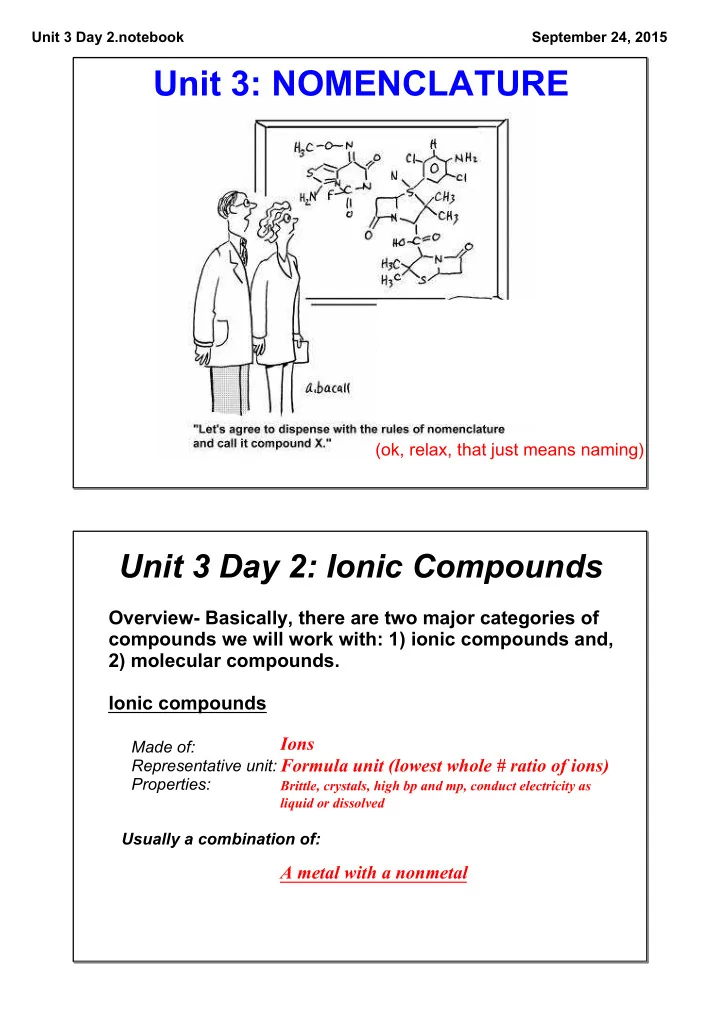

Unit 3 Day 2.notebook September 24, 2015 Unit 3: NOMENCLATURE (ok, relax, that just means naming) Unit 3 Day 2: Ionic Compounds Overview Basically, there are two major categories of compounds we will work with: 1) ionic compounds and, 2) molecular compounds. Ionic compounds Ions Made of: Formula unit (lowest whole # ratio of ions) Representative unit: Properties: Brittle, crystals, high bp and mp, conduct electricity as liquid or dissolved Usually a combination of: A metal with a nonmetal
Unit 3 Day 2.notebook September 24, 2015 1 2 H He Hydrogen Helium 3 4 5 6 7 8 9 10 Li Be B C N O F Ne Lithium Beryllium Boron Carbon Nitrogen Oxygen Fluorine Neon 11 12 13 14 15 16 17 18 Na Mg Al Si P S Cl Ar Sodium Magnesium Aluminium Silicon Phosphorus Sulfur Chlorine Argon 19 20 21 22 23 24 25 26 27 28 29 30 31 32 33 34 35 36 K Ca Sc Ti V Cr Mn Fe Co Ni Cu Zn Ga Ge As Se Br Kr Potassium Calcium Scandium Vanadium Chromium Manganese Iron Cobalt Copper Zinc Titanium Nickel Gallium Germanium Arsenic Selenium Bromine Krypton 37 38 39 40 41 42 43 44 45 46 47 48 49 50 51 52 53 54 Rb Sr Y Zr Nb Mo Tc Ru Rh Pd Ag Cd In Sn I Sb Te Xe Rubidium Strontium Yttrium Zirconium Niobium Molybdenum Technetium Ruthenium Rhodium Palladium Silver Cadmium Antimony Tellurium Iodine Xenon Indium Tin 55 56 57 72 73 74 75 76 77 78 79 80 81 82 83 84 85 86 Cs Ba La Hf Ta W Re Os Ir Pt Au Hg Tl Pb Bi Po At Rn Cesium Barium Lanthanum Hafnium Tantalum Tungsten Rhenium Osmium Mercury Iridium Platinum Gold Thallium Lead Bismuth Polonium Astatine Radon 87 88 89 104 105 106 107 108 109 Fr Ra Ac Rf Db Sg Bh Hs Mt Francium Radium Actinium Rutherfordium Dubnium Seaborgium Bohrium Hassium Meitnerium 58 59 60 61 62 63 64 65 66 67 68 69 70 71 Ce Pr Nd Pm Sm Eu Gd Tb Dy Ho Er Tm Yb Lu Cerium Praseodymium Neodymium Promethium Samarium Europium Gadolinium Terbium Dysprosium Holmium Erbium Thulium Ytterbium Lutetium 90 91 92 93 94 95 96 97 99 98 100 101 102 103 Th Pa U Np Pu Am Cm Bk Cf Es Fm Md No Lr Thorium Protactinium Uranium Neptunium Plutonium Americium Curium Berkelium Californium Einsteinium Fermium Mendelevium Nobelium Lawrencium II.Ionic compounds An atom (or bonded atoms) lose or gain electrons and therefore What’s an ion? has (have) a net positive or negative charge How is an ion made? What types of ions are around? How do individual ions get their names? Cation + ions (lost electron(s)), same name as element (watch for mult. oxidation state). ions (gained electron(s)), typically ends in "ide" EX: Anion multiatom ion, see sheet for name EX: Polyatomic ion How can we tell an ion’s charge? “Picture” of an ionic compound:
Unit 3 Day 2.notebook September 24, 2015 Writing formulas for ionic compounds • Must add up to 0 “crossing” charges EX: • + first • cross numbers NOT charges magnesium and chloride • put polyatomics in ( ) • simplify if possible barium and phosphate Magnesium and oxide aluminum and phosphate sodium and sulfate tin (IV) and oxide
Unit 3 Day 2.notebook September 24, 2015 Naming ionic compounds: MAKE SURE IT IS IONIC!!!! Name the positive ion then name the negative ion Rule: Don’t forget multiple oxidation state cations Examples:
Attachments watermolec.gif waterliquid.gif waterice.gif water2.jpg
Recommend
More recommend